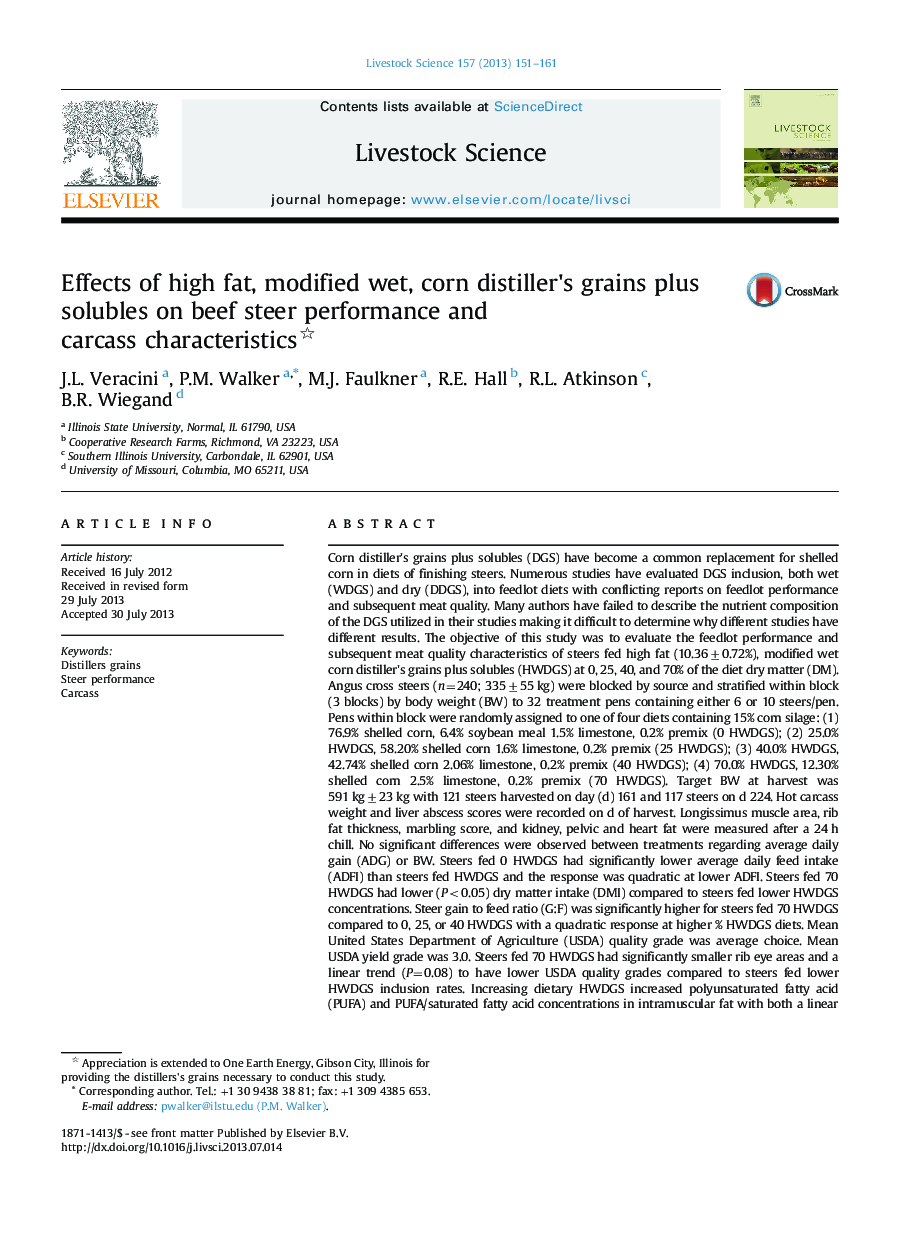| کد مقاله | کد نشریه | سال انتشار | مقاله انگلیسی | نسخه تمام متن |
|---|---|---|---|---|
| 5790358 | 1109492 | 2013 | 11 صفحه PDF | دانلود رایگان |
عنوان انگلیسی مقاله ISI
Effects of high fat, modified wet, corn distiller's grains plus solubles on beef steer performance and carcass characteristics
ترجمه فارسی عنوان
اثرات غلات حاوی مقادیر بالای چربی، اصلاح شده مرطوب، ذرت و محلول در عملکرد گوشت گاو و ویژگی های لاشه
دانلود مقاله + سفارش ترجمه
دانلود مقاله ISI انگلیسی
رایگان برای ایرانیان
کلمات کلیدی
غلات دانه بندی شده، عملکرد هدایت، لاشه،
موضوعات مرتبط
علوم زیستی و بیوفناوری
علوم کشاورزی و بیولوژیک
علوم دامی و جانورشناسی
چکیده انگلیسی
Corn distiller's grains plus solubles (DGS) have become a common replacement for shelled corn in diets of finishing steers. Numerous studies have evaluated DGS inclusion, both wet (WDGS) and dry (DDGS), into feedlot diets with conflicting reports on feedlot performance and subsequent meat quality. Many authors have failed to describe the nutrient composition of the DGS utilized in their studies making it difficult to determine why different studies have different results. The objective of this study was to evaluate the feedlot performance and subsequent meat quality characteristics of steers fed high fat (10.36±0.72%), modified wet corn distiller's grains plus solubles (HWDGS) at 0, 25, 40, and 70% of the diet dry matter (DM). Angus cross steers (n=240; 335±55 kg) were blocked by source and stratified within block (3 blocks) by body weight (BW) to 32 treatment pens containing either 6 or 10 steers/pen. Pens within block were randomly assigned to one of four diets containing 15% corn silage: (1) 76.9% shelled corn, 6.4% soybean meal 1.5% limestone, 0.2% premix (0 HWDGS); (2) 25.0% HWDGS, 58.20% shelled corn 1.6% limestone, 0.2% premix (25 HWDGS); (3) 40.0% HWDGS, 42.74% shelled corn 2.06% limestone, 0.2% premix (40 HWDGS); (4) 70.0% HWDGS, 12.30% shelled corn 2.5% limestone, 0.2% premix (70 HWDGS). Target BW at harvest was 591 kg±23 kg with 121 steers harvested on day (d) 161 and 117 steers on d 224. Hot carcass weight and liver abscess scores were recorded on d of harvest. Longissimus muscle area, rib fat thickness, marbling score, and kidney, pelvic and heart fat were measured after a 24 h chill. No significant differences were observed between treatments regarding average daily gain (ADG) or BW. Steers fed 0 HWDGS had significantly lower average daily feed intake (ADFI) than steers fed HWDGS and the response was quadratic at lower ADFI. Steers fed 70 HWDGS had lower (P<0.05) dry matter intake (DMI) compared to steers fed lower HWDGS concentrations. Steer gain to feed ratio (G:F) was significantly higher for steers fed 70 HWDGS compared to 0, 25, or 40 HWDGS with a quadratic response at higher % HWDGS diets. Mean United States Department of Agriculture (USDA) quality grade was average choice. Mean USDA yield grade was 3.0. Steers fed 70 HWDGS had significantly smaller rib eye areas and a linear trend (P=0.08) to have lower USDA quality grades compared to steers fed lower HWDGS inclusion rates. Increasing dietary HWDGS increased polyunsaturated fatty acid (PUFA) and PUFA/saturated fatty acid concentrations in intramuscular fat with both a linear and quadratic effect. High fat modified WDGS can be fed up to 70% of diet DM without compromising feedlot performance, carcass characteristics, or meat quality.
ناشر
Database: Elsevier - ScienceDirect (ساینس دایرکت)
Journal: Livestock Science - Volume 157, Issue 1, October 2013, Pages 151-161
Journal: Livestock Science - Volume 157, Issue 1, October 2013, Pages 151-161
نویسندگان
J.L. Veracini, P.M. Walker, M.J. Faulkner, R.E. Hall, R.L. Atkinson, B.R. Wiegand,
